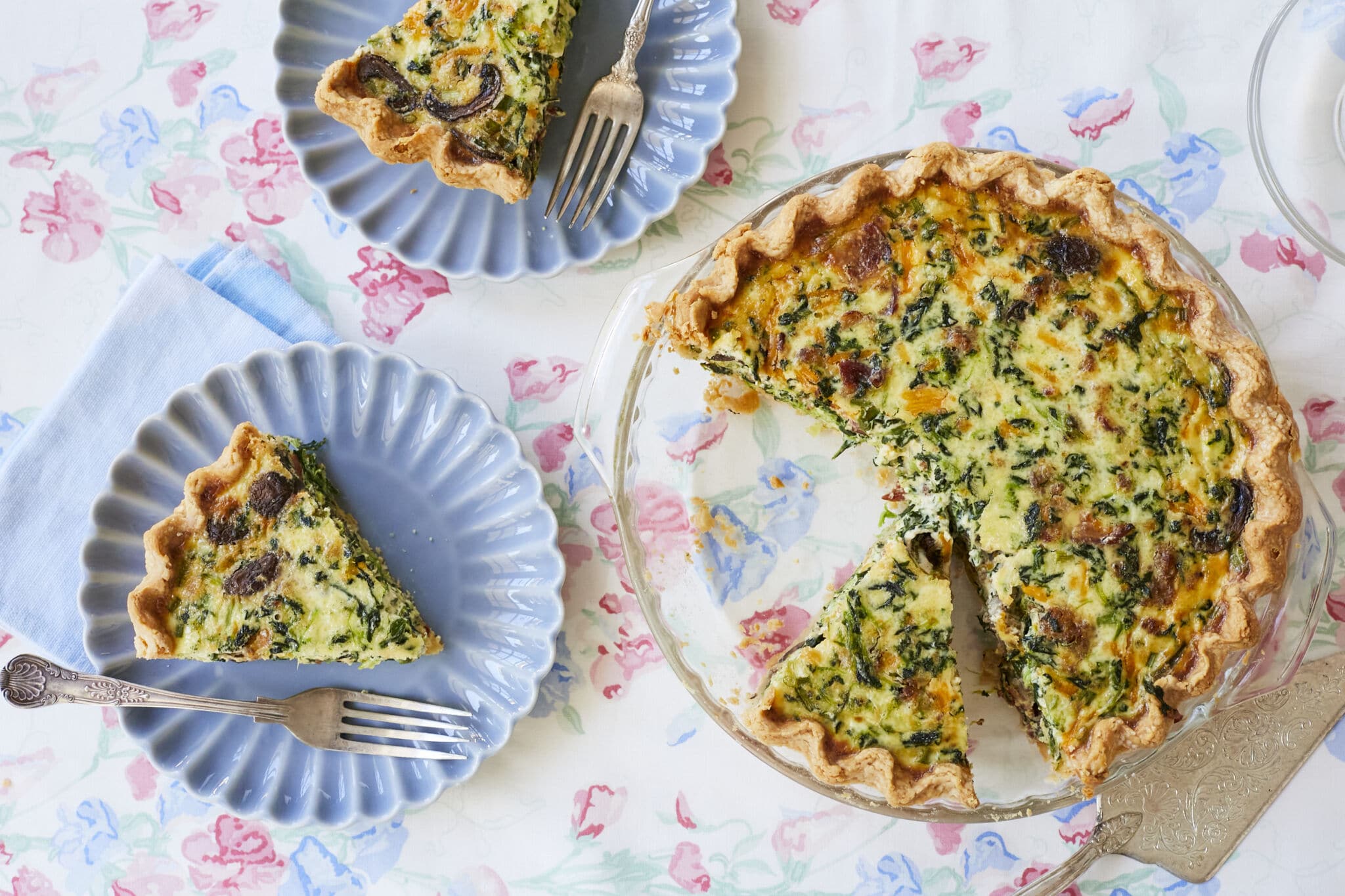
This post may contain affiliate links. Please see my full disclosure for details.
Hi Bold Bakers!
WHY YOU’LL LOVE THIS RECIPE: This Homemade Quiche recipe couldn’t be easier to make — or harder to resist! It’s a delightful blend of simplicity and flavor, featuring a flaky Buttermilk Pie Crust, hearty custard, and customizable fillings that make it perfect for any meal.
- Effortless Preparation: Prepared in just 30 minutes with basic kitchen tools and ingredients.
- Customizable Fillings: Tailor the quiche with your favorite proteins, vegetables, and cheeses.
- Versatile Delight: Enjoy it for breakfast, lunch, or dinner, making it a great dish for any time of day.
On weekdays, you may opt for on-the-go breakfast foods for school or work. But, on those weekend mornings when you may have a bit more time to spend in the kitchen with family and friends, what can you make? This quiche is more than just a meal; it’s a tradition that connects generations and brings us closer together.
IMPORTANT NOTE: This recipe was improved and updated on 6/20/2024, to include a NEW STEP-BY-STEP tutorial video, explanations and substitutes of key ingredients, answers to the most frequently asked questions, and more Pro Chef Tips.
Table Of Contents
- What Is Quiche?
- Tools You Need To Make Quiche
- Ingredients You Need To Make Homemade Quiche
- Homemade Vs. Store-Bought Pie Crust
- How To Make Quiche
- Gemma’s Pro Chef Tips
- Can I Make Quiche In Advance?
- How To Store Leftover Quiche
- How to Make Eggless Quiche
- FAQs
- More Savory Tart Recipes

What Is Quiche?
Quiche (pronounced KEESH) is a savory French tart composed of pastry crust and egg filling or custard. There are many varieties of quiche made with meat, cheese, vegetables, or seafood. It’s predominantly considered a hot breakfast food, but you can enjoy it for any meal and at any temperature.
- Though quiches are typically known to be a French dish, there have been other accounts of quiches prior to the French. Quiche Lorraine, a traditional dish made of eggs, heavy cream, bacon, and Swiss cheese, originated in Germany during the 1500s.
- Lucky for quiche lovers, I have a homemade Quiche Lorraine recipe you can try here. If you’re looking to make a tasty quiche in minutes, check out my Microwave Mug Quiche recipe while you’re at it.
Tools You Need
- Measuring cups and spoons
- 9-inch (23 cm) deep dish pie pan
- Parchment paper
- Pie weights (alternatively, rice, beans, etc.)
- Mixing bowls
- Whisk
- Spoon
Quiche Ingredients
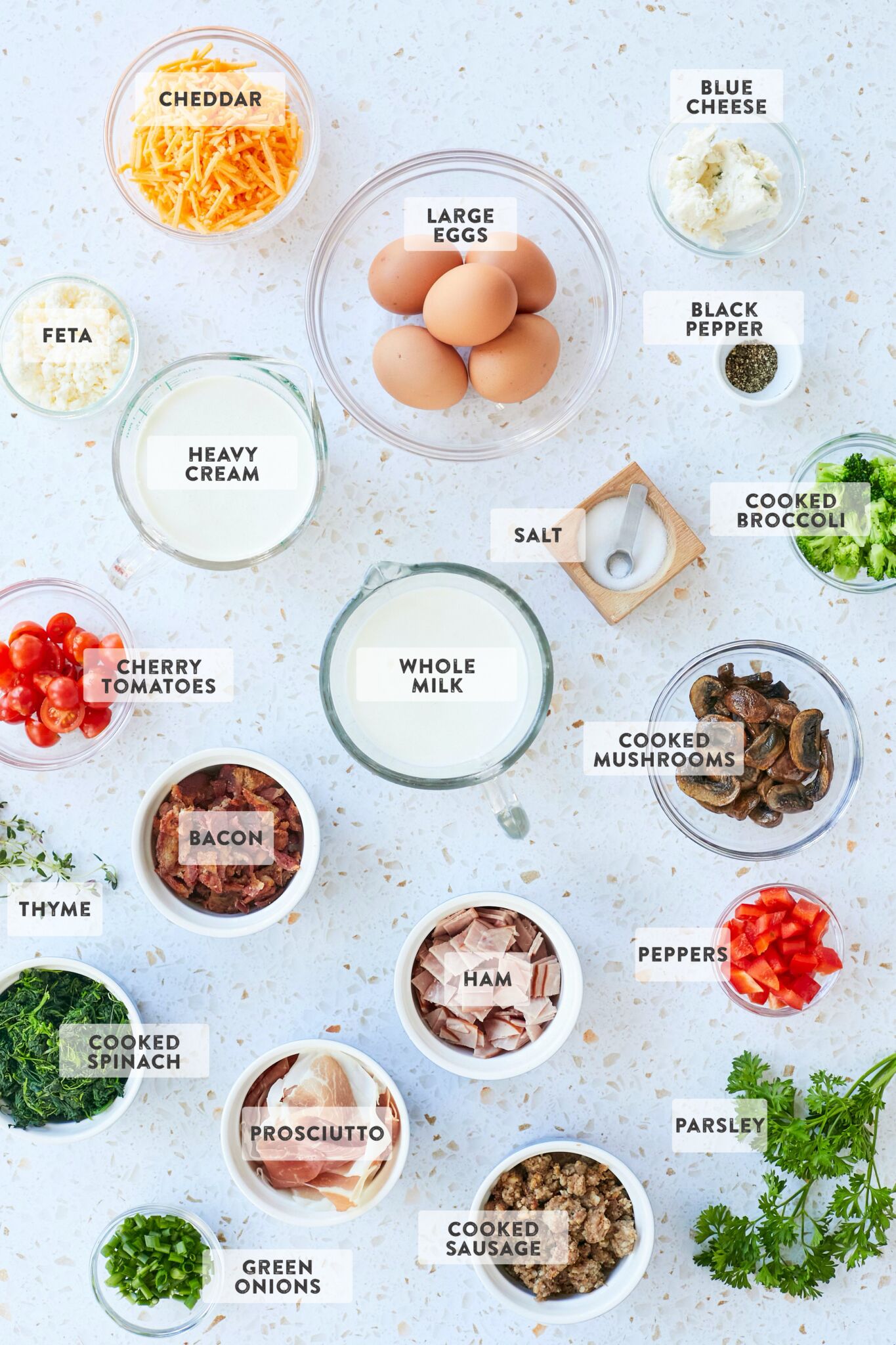
Pie Crust: Homemade Buttermilk Pie Crust
Any good quiche begins with a dependable crust.
- For this recipe, I used my Homemade Buttermilk Pie Crust recipe because it’s got a wonderful buttery flavor and flaky texture.
- However, if you’re pinched for time, you can buy a premade crust. Just be sure it’s good quality and properly defrosted if used from frozen.
- Make sure to Blind Bake Pie Crust to ensure a crisp crust.
Custard Base:
- Eggs
- Eggs provide structure and stability to the custard, helping it set properly while adding richness and flavor.
- Make sure to use good quality, large eggs at room temperature.
- Heavy cream
- Heavy cream adds creaminess and a luxurious texture to the custard, contributing to its richness.
- Alternatively, you can use full-fat coconut milk.
- Milk
- Milk lightens the custard by balancing the heaviness of the cream, ensuring a smooth and creamy texture without being overly rich.
- Use some full-fat, whole milk for this recipe. Or substitute full-fat dairy-free milk such as coconut milk, almond milk, oat milk, or cashew milk for milk.
- Salt
- Just a touch will bring out the flavors of your ingredients.
- Black Pepper
- Pepper will add some depth and spice to your quiche.
Mix-Ins:
- Cheese
- Cheese adds flavor, creaminess, and a slightly gooey texture when melted, complementing the custard.
- Grated, hard but meltable cheese, like cheddar or gruyere, or crumbled cheese, like feta or blue cheese, is perfect for a quiche.
- Check out our Vegan Cheese Recipe for a vegan-friendly alternative.
- Protein
- Provides additional flavor, texture, and heartiness, making the quiche more filling and nutritious.
- We recommend using cooked and crumbled bacon or sausage or diced cured meat such as ham or prosciutto.
- Veggies
- Contribute flavor, texture, and nutritional value, adding color and freshness to the quiche.
- You can use steamed, sauteed, roasted, or diced vegetables such as spinach, broccoli, mushrooms, kale, onions, peppers, or cherry tomatoes.
How To Make Quiche
To Blind Bake The Pie Crust:
- Preheat the oven to 350°F (180°C) and line a deep dish pie pan with the pie crust.
- Line the crust with parchment paper, fill it with pie weights, and bake for 15-20 minutes.
- Remove the paper and weights and continue baking for 5-10 more minutes until the bottom of the crust looks dry and shows a bit of color. Remove from the oven and lower the heat to 325°F (165°C). Set aside the crust.
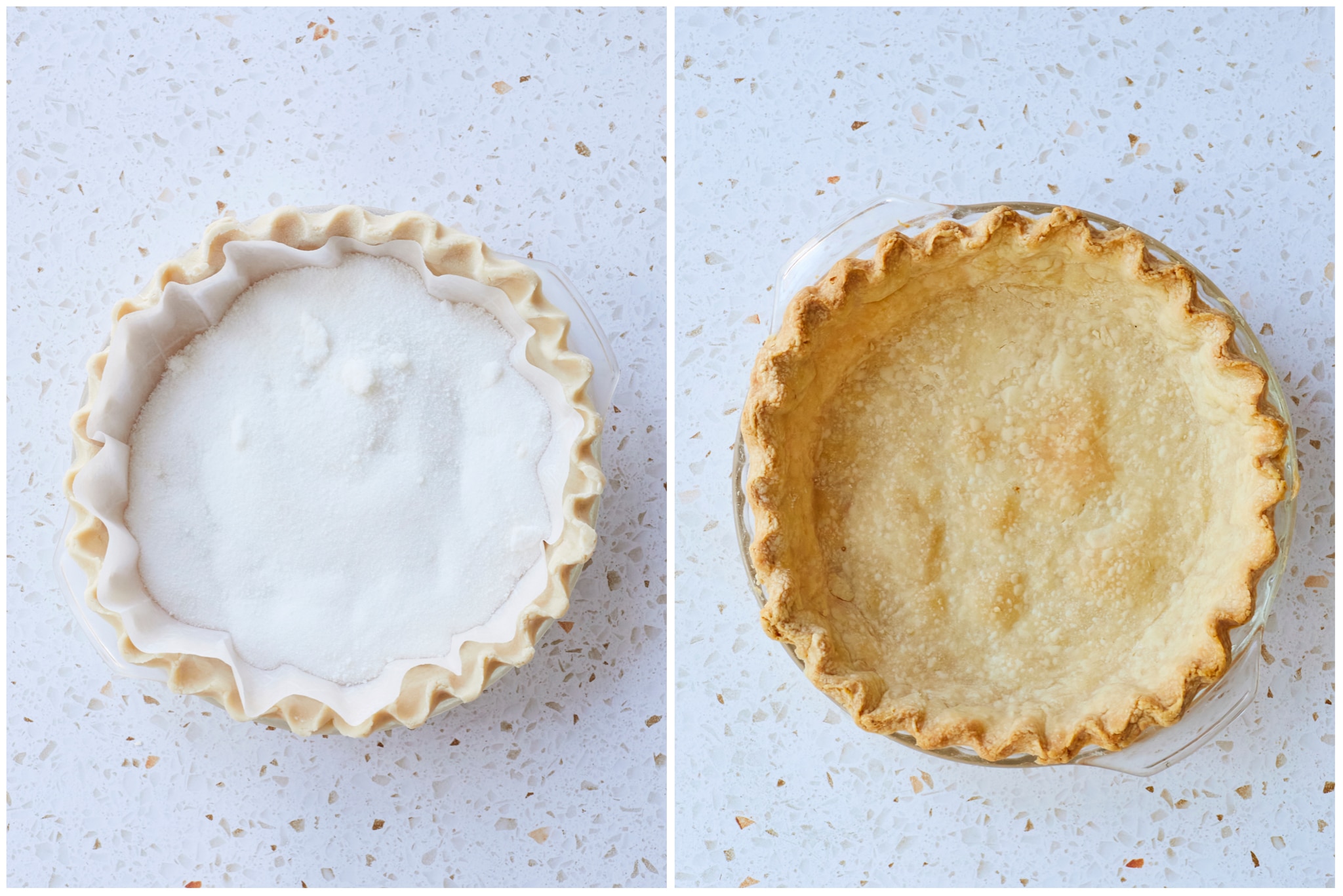
To Make The Filling:
- In a bowl, whisk together the eggs, cream, milk, salt, and pepper until smooth. Lastly, stir in your choice of cheese, protein, and vegetables.

How To Bake Quiche:
- Pour the filling into the crust and bake for 45-60 minutes until the filling is slightly puffed and set in the middle.
- Let cool down for 30 minutes before serving.
- This is best the day it is made, but you can store leftovers, loosely covered, in the refrigerator for up to 3 days.
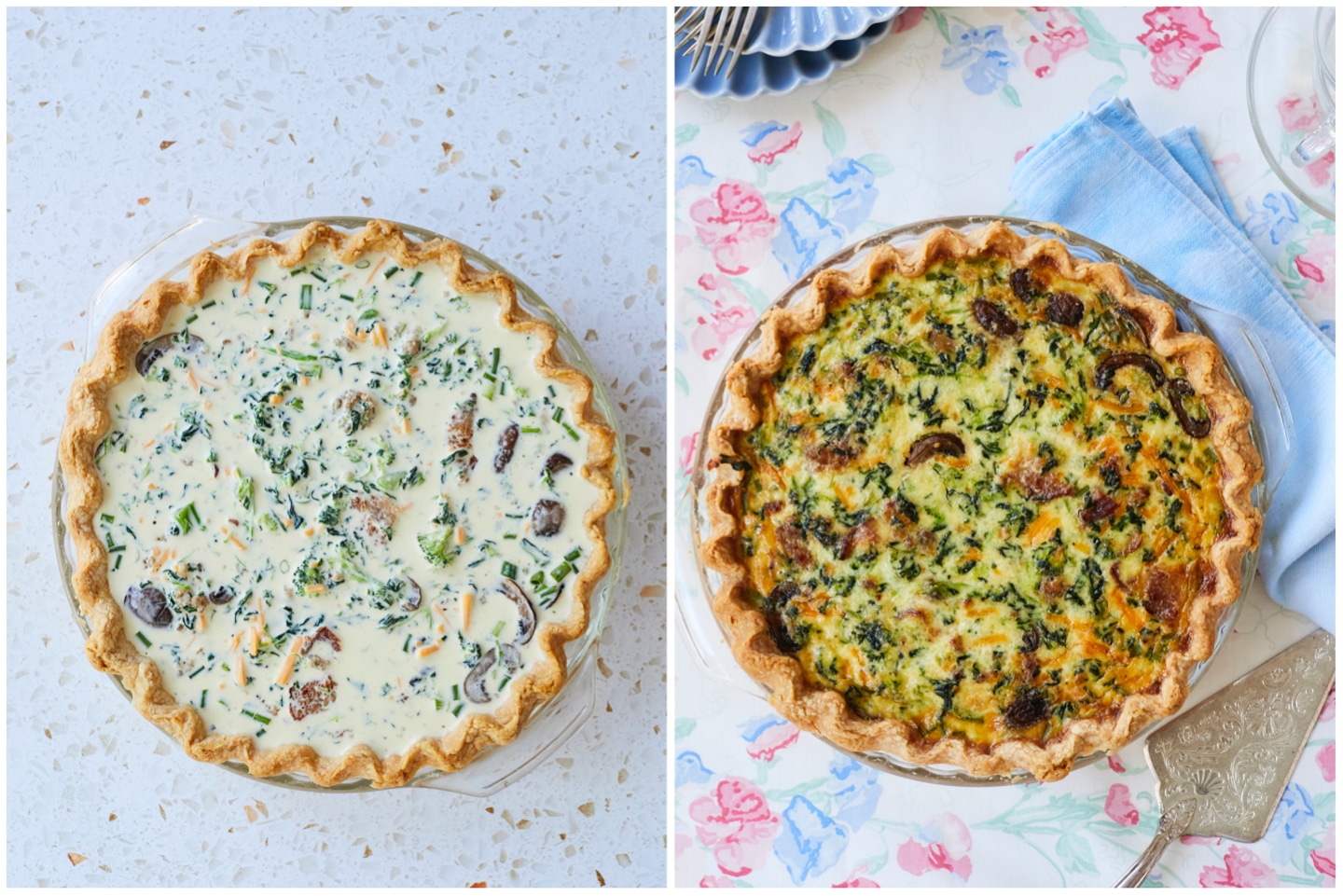
Gemma’s Pro Chef Tips To Make Homemade Quiche
- Some quiche recipes don’t require blind-baking the crust, but this extra step ensures a crispy bottom.
- Keeping the custard ingredients at room temperature ensures even and quick baking.
- You can bring the milk and cream to room temperature in the microwave or very briefly in a small pot over low heat on the stove.
- For a vegetarian quiche, just double the amount of veggies and leave out the meat.
- If the edges of the crust start to over-brown before the quiche is ready, cover the quiche loosely with foil for the remainder of the baking time.
- For a gluten-free quiche, use my Gluten Free Pie Crust!
- When making the crust, rub the flour and butter together until it reaches the texture of breadcrumbs or wet sand. This means the butter is evenly distributed, and that’s what creates the perfect crust.
- Let your crust rest. The crust needs time to chill before it can be rolled out. Working with a colder crust means working it less, which is another secret to a great crust – you never want to handle it too much.
- For an extra beautiful quiche, crimp the edges of your crust with your fingers!
Can I Make Quiche Ahead Of Time?
I recommend making quiche an hour or two before you want to serve it, as it’ll be the freshest and warmest then. However, you can always make quiche ahead of time and serve it by reheating it.
How To Store Quiche
Though quiche tastes amazing the day it’s made, it also makes for great leftovers. If you have leftover quiche, store it loosely covered in the fridge for up to 3 days.
To reheat, cut your quiche into slices and pop it in the microwave or a low oven.
How to Make Eggless Quiche
A quiche without eggs? It sounds unheard of, but you can substitute eggs with other amazing ingredients!
- Chickpea flour, or garbanzo bean flour, sets up and binds with other ingredients while baking. It also creates a similar texture to eggs once baked. It has a very neutral flavor, so it shouldn’t overpower your quiche. I suggest adding 1 cup of chickpea flour to the cream mixture.
- For more information on egg substitutes, check out this article!
FAQs
Why is my quiche watery?
- Your quiche can seem watery when it comes out of the oven because it needs some time to set before serving. Since the filling is a custard, it’s normal for there to be a bit of a wobble. As a quick test, gently press your finger on the custard. It should spring back slightly when done and feel firm under your finger.
- If your quiche is not set and watery even after 30 minutes of setting up, you may have run into a few problems. Some of the most common causes of watery quiche are overbaking or underbaking your quiche, getting the egg and dairy ratio wrong, or using ingredients that have too much liquid.
Can I save a watery quiche?
The good news is you can save a watery quiche!
- If you happen to underbaked the quiche, pop it back in the oven for a few extra minutes. Keep doing this until your filling is firm with a slight spring.
- If it’s overbaked on top but still liquid underneath, wrap the top of it with aluminum foil and pop it back in the oven on the lower rack. This should help the inner part of the custard to cook without burning the top.
- For other watery quiche causes, make sure to use the right size eggs, measure the proper amount of dairy and keep your ingredients as dry as possible before use.
Why is my quiche leaking?
This is a common problem if you don’t blind-bake your crust. Blind-baking allows the crust to harden before you put in your wet filling. If this step is skipped, all of your filling will seep into the crust and cause it to leak.
How do I keep my quiche from getting soggy on the bottom?
- Even after blind-baking, you may end up with a Homemade Quiche with a soggy bottom.
- This can be solved by removing extra liquid and moisture from the ingredients you use beforehand. For example, you can sautee or roast some of your vegetables before mixing them into your custard to get rid of extra moisture.
Why is my quiche sinking?
You want a lovely fluffed-up quiche at the end of the day, but sometimes it ends up sinking and sad. If you bake your quiche too quickly, it will fluff up, sink and have an unsavory rubbery texture. Make sure to cook it at the right temperature to prevent this in the future.
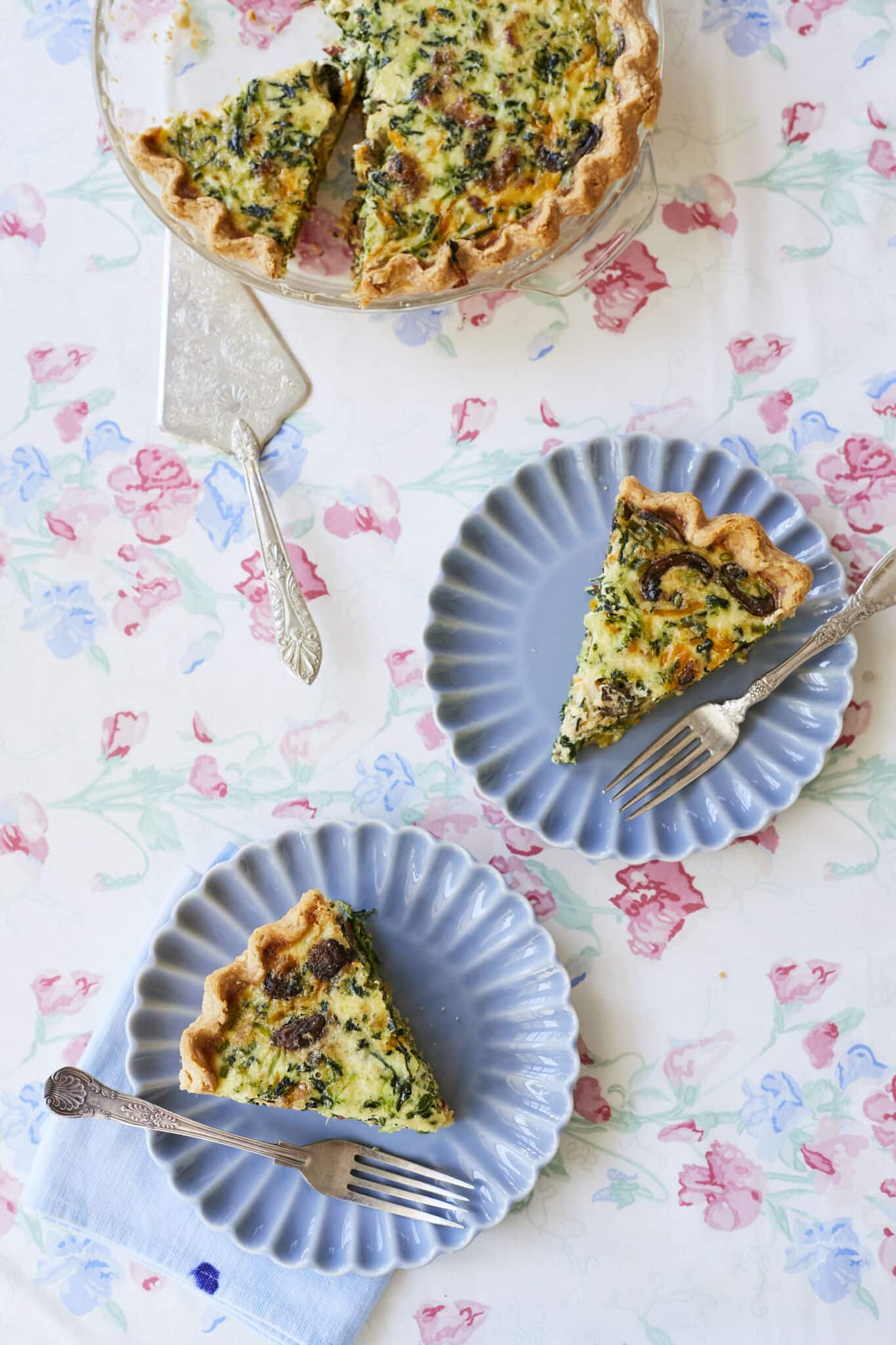
More Savory Tart Recipes:
- Toaster Oven Breakfast Tart
- Caprese Savory Tart
- Pizza Savory Pop-Tarts
- Ham and Cheese Savory Pop-Tarts
- Spinach Ricotta Savory Pop-Tarts
- 3-Ingredient Flatbread
And don’t miss more everyday baking recipes in my NEW Bigger Bolder Baking Every Day Cookbook!
IMPORTANT NOTE: This recipe was improved and updated on 6/20/2024, to include a NEW STEP-BY-STEP tutorial video, explanations and substitutes of key ingredients, answers to the most frequently asked questions, and more Pro Chef Tips.
Watch The Recipe Video!
How to Make Quiche
Ingredients
Buttermilk Pastry
- 1 recipe Buttermilk Pie Crust
Custard Base
- 5 large eggs, at room temperature
- ¾ cup (6 fl oz/180 ml) heavy cream
- ½ cup (4 fl oz/120 ml) milk
- 1 teaspoon salt
- ½ teaspoon black pepper
Mix-Ins
- Cheese: 1 cup (6 oz/170 g) grated hard but meltable cheese like cheddar or gruyere, or crumbled cheese like feta or blue cheese
- Protein: 1 cup (8 oz/225 g) cooked and crumbled bacon or sausage, or diced cured meat such as ham or prosciutto
- Veggies: 1 cup (10 oz/282 g) steamed, sauteed, or roasted diced vegetables such as spinach, broccoli, mushrooms, kale, onions, peppers, cherry tomatoes, etc.
Instructions
To Blind Bake The Pie Crust
- Preheat the oven to 350°F (180°C) and line a 9-inch (23 cm) deep dish pie pan with the buttermilk pie crust.
- Line the crust with parchment paper, fill it with pie weights (rice, beans, etc.), and bake for 15-20 minutes.
- Remove the paper and weights and continue baking for 5-10 more minutes until the bottom of the crust looks dry and just beginning to show a bit of color. Remove from the oven and lower the heat to 325°F (165°C). Set the crust aside while you prepare the filling.
To Make The Filling
- In a large bowl, whisk together the eggs, cream, milk, salt, and pepper until smooth. Lastly, stir in your choice of cheese, protein, and vegetables.
To Bake The Quiche
- Pour the filling into the crust and bake for 45-60 minutes, until the filling is slightly puffed and set in the middle. It will spring back slightly when done and feel firm under your finger.
- Let cool down for 30 minutes before serving. This is best the day it is made, but you can store leftovers, loosely covered, in the refrigerator for up to 3 days.
Recipe Notes
Gemma's Pro Chef Tips To Make Homemade Quiche
- Some quiche recipes don't require blind-baking the crust, but this extra step ensures a crispy bottom.
- Keeping the custard ingredients at room temperature ensures even and quick baking.
- You can bring the milk and cream to room temperature in the microwave or very briefly in a small pot over low heat on the stove.
- For a vegetarian quiche, just double the amount of veggies and leave out the meat.
- If the edges of the crust start to over-brown before the quiche is ready, cover the quiche loosely with foil for the remainder of the baking time.
- For a gluten-free quiche, use my Gluten Free Pie Crust!
- When making the crust, rub the flour and butter together until it reaches the texture of breadcrumbs or wet sand. This means the butter is evenly distributed, and that's what creates the perfect crust.
- Let your crust rest. The crust needs time to chill before it can be rolled out. Working with a colder crust means working it less, which is another secret to a great crust – you never want to handle it too much.
- For an extra beautiful quiche, crimp the edges of your crust with your fingers!
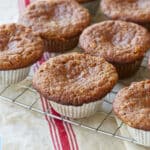


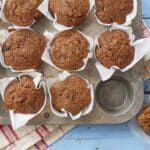
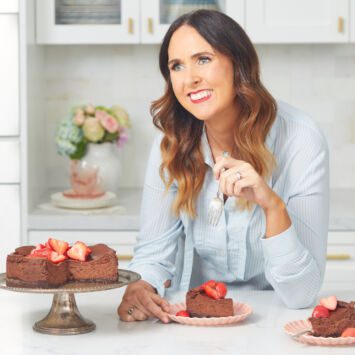


Oh my! I made this quiche for lunch today using sharp cheddar cheese, broccoli, and diced ham. It was absolutely delicious; wouldn’t change a thing! The blind-baked buttermilk pie crust was flaky and added soooo much flavor to the already amazing flavors of the quiche. I plan to make this again really soon. Thanks for another winning recipe, Gemma!
Yum! Love scratch baking. You make it easy and I love knowing what’s in my food. Super easy savory crust.
Your recepies are so easyy…nd yumy
I follow u from pakistan.
Lots of love.
Hi Gemma – At what temperature is the quiche baked at? In video you say 350F for 45-60 minutes but in the printed recipe on your blog you state 325F for 45-60 minutes.
Can I use salt for the blind bake?
I love making no-crust quiche in my vintage casserole dishes!! And I thought I had it down to a science, except the middle would never cook and I’d have to go in with a fork to mix it up, and then bake it more. But your instructions were the answer to my dilemma! I was cooking it too hot!! Thanks!!
Can I make these crustless in a muffin tin?
Hi Gemma. I love your recipes and have always wanted to make a homemade quiche. I just ordered a deep dish pie pan and will make this quiche next weekend. So not critical to blind bake? Do you poke the pie dough with a fork before filling the pan? Lastly, confirming this recipe is for a deep dish pan. Thank you very much! Rosemary
Gemma, I so truly enjoy your recipes, I want to thank you 😊 for sharing them with us. I look forward to seeing more of you.
I make quiche frequently and I use all sorts of add ins, usually minimum of 10 eggs, meat combinations, veg combinations, cheese combinations, like chev goat cheese a lot! I never blind bake the crust and it’s always flaky. Always complimented on my flaky crust! 60 to 80 min baking time. They are rarely the same. All add in veg and meats are pre cooked.